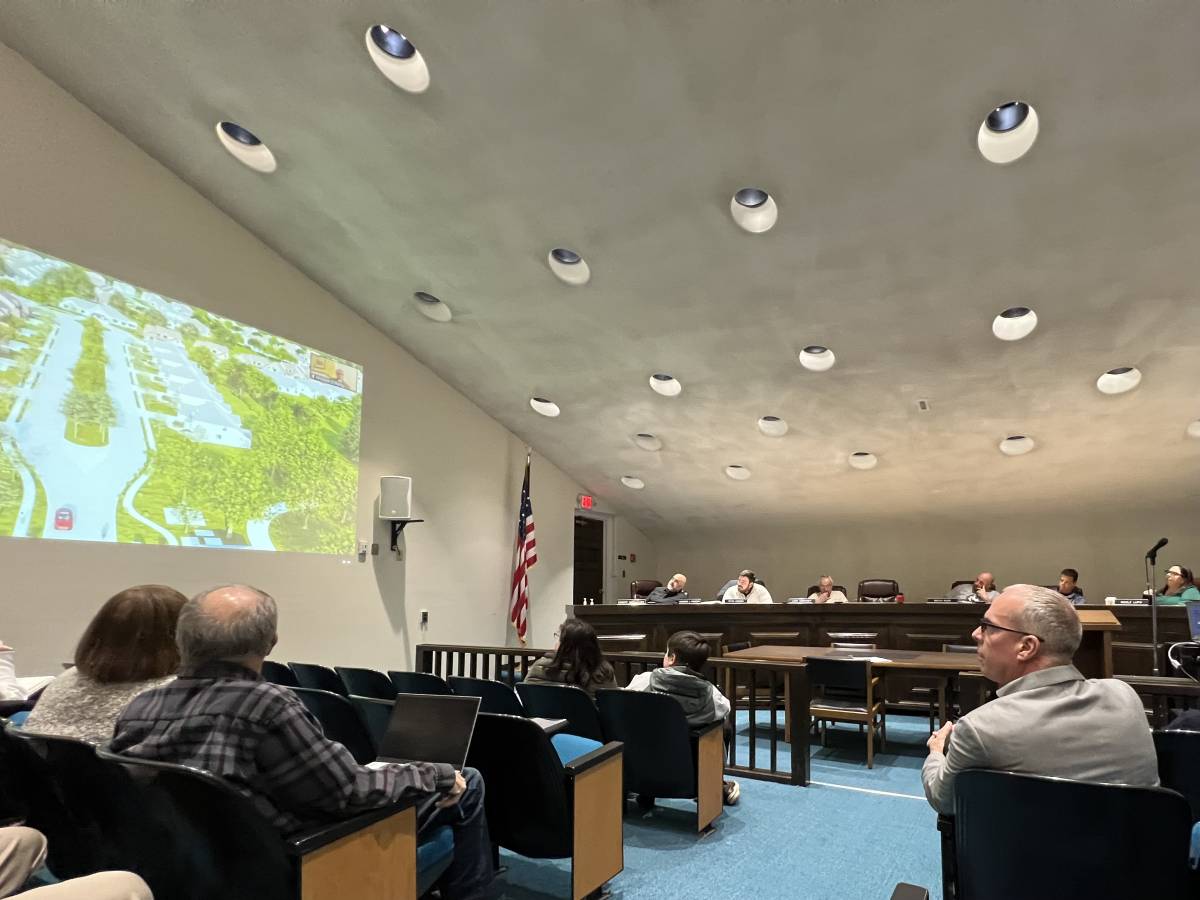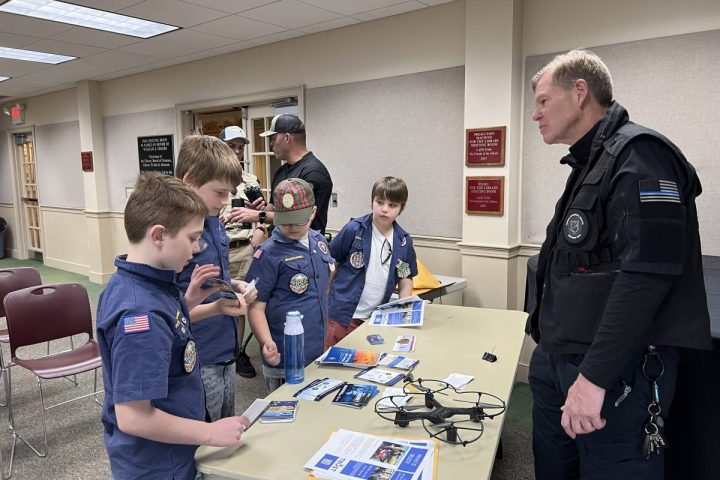MONROE, CT — Developers promoted a proposal to build Quarry Ridge, a 99-unit condo complex on 154 acres on Turkey Roost Road and Cobblers Hill Court, for its preservation of 81 acres of open space, while touting a transformation of the former illegal quarry into a greener parcel with a net positive for the town’s tax base.
However, close to 50 residents attending the Monroe Planning and Zoning Commission’s special meeting Tuesday night expressed concerns over adding to the traffic on Turkey Roost, which they say is already a dangerous road, the impact of more children on the school system, drainage, blasting and potential damage to their wells.
The plan already has Inland Wetlands Commission approval and Tuesday’s planning and zoning hearing was continued to March 12.
Stanley Gniazdowski, president of Realty Concepts Incorporated, performed an economic impact study, which projects 64 school age children from the 99 four bedroom condo units.

His data shows there may be a net positive of $674,000 in annual tax revenue for the town. Over the course of 10 years, Gniazdowski said it would bring in millions, enough for an addition to one of the town’s schools.
But several commissioners, and members of the public, expressed their belief that the complex would bring in significantly more students than 64 and were skeptical of the cost and revenue projections.
“You say millions in revenue for the town. I see a loss,” Vice Chairman Bruno Maini said.
Maini said he doesn’t know if Gniazdowski was talking about more revenue for town businesses, but added, “I don’t see millions in that.”
Maini asked how many condos would be affordable and was told none. He noted how affordable housing in Monroe is different than affordable housing in other communities and asked the developer to help the town increase its affordable housing units.
Nicole Lupo, a commission alternate, said she found it hard to believe the housing would bring in only 64 students.
Maini said housing with one-to-two bedrooms could have less of an impact on the school system, but said he can’t imagine someone buying a home with four bedrooms not having kids.
Commissioner Leon Ambrosey noted how students with special needs drastically increase per pupil expenditures and wanted a projection of how many of the new students could need those services.
Gniazdowski said everything was factored into the numbers received from the Connecticut Department of Education and the Monroe school district, but said he could get more information from Superintendent Joseph Kobza.
Each condo would cost around $800,000 and have a two-car-garage and amenities include a clubhouse and community pool.
A four-acre-parcel on Cobblers Hill Court would be set aside and deed restricted to only allow one single family home to be built on it.
Chris Russo, the attorney for the applicant, Quarry Ridge Associates LLC, said a separate approval would be needed to build a house there, adding it is not part of the current application.
He said people have illegally hunted on open space on the property and building a home there could serve as a deterrent.
Some blasting
Jason Edwards of J. Edwards & Associates, an Easton engineering firm, expressed confidence in the drainage plan for the property, which includes three large basins, one small basin and a rain garden.
He showed aerial photos of the land, one barren from the decades long quarry operation (which preceded his client who bought the property in 2003), and another showing a greener property with richer soils.
Seventy five trees would be removed during construction, but the landscaping plan includes the planting of over 300 new trees and over 3,000 new shrubs.
There is a box turtle protection plan and landscaping and open space preservation will also mean improved habitats for owls and bats, according to Edwards.
Edwards said earthwork done during the environmental remediation of the property brought the grading to the level needed to build, so only minimal blasting is likely.
Ambrosey asked how much material from crushing on the site would be hauled away and sold. Edwards said there are no plans to export material off the site.
Ambrosey asked for an estimate of how much material would need to be removed by blasting, because he said he wants to avoid the establishment of a crushing operation. Edwards said he will get that for him.
Construction of the condos would be done in four phases. Russo said a town permit limits a build to five years and his client would try to complete the project in that time frame.
“We’re asking for a permit for the entire build out,” Edwards said.
‘No measurable impact’
 Nick Havan, the principal transportation engineer of SLR, presented the traffic study.
Nick Havan, the principal transportation engineer of SLR, presented the traffic study.
The project is “estimated to generate 934 vehicle trips daily (467 vehicles entering and 467 vehicles exiting), with 74 vehicle trips (19 vehicles entering and 55 vehicles exiting) during the weekday morning peak hour and 98 vehicle trips (63 vehicles entering and 35 vehicles exiting) during the weekday evening peak hour,” according to the study.
The study, which also includes a five-year crash data analysis, concluded SLR’s opinion “that the increase in traffic because of the proposed project will have no measurable impact on the surrounding roadway system. As such, no traffic mitigation is necessary.”
The firm also recommends regular trimming of vegetation around the site driveway to maintain adequate sight distances.
Maini said the study’s numbers may work on a regular road, but added “there’s nothing regular about Turkey Roost Road.”
“It’s scary now and imagine doubling [the traffic],” he said, to the approval of many residents in the audience who clapped.
Commissioner Robert Westlund said Turkey Roost Road is a cut-thru road with a bad intersection at the end, where it meets Fan Hill Road and Elm Street.
“Turkey Roost is a horrible road,” Ambrosey said. “There’s sightline issues.”
Ambrosey asked for a safety audit of the area to be done.
The ‘Indianapolis 500’
Trout Unlimited submitted a letter noting the property’s close proximity to Copper Mine Brook, which is home to native Brook Trout, and the Halfway River, which has both native Brook Trout and wild Brown trout.
The organization asked the commission to ensure that anything it approves will not result in pavement that gets hot in the summer, raising the temperature of nearby waterways, nor anything that could result in contaminated runoff.
During the public comment portion of the hearing, Michael Ganino, who lives on Mill Brook Terrace, spoke against the application.
“I think this development is good for the developers. It’s good for the box turtles, the bats and the owls, but not the school system,” he said of the potential impact on the district.
Ganino said he thinks Fawn Hollow Elementary School will already need temporary classrooms.
“I think the number of cars introduced to an already dangerous road is understated,” he added of Turkey Roost Road. “I think this project will have a negative impact on the town, the school district and the quality of life in Monroe.”
Ray Swensky, of Turkey Roost Road, shared concerns over the impact on the street, including a disruption to install a water line. He also expressed concerns over stormwater runoff from the property.
Swensky, a resident of 40 years, recalled a development of “beautiful houses” on Lynn Drive years ago. He said drainage plans may hold up for a few years, but water eventually flows down. His backyard is now under solid ice, he said.
John Quinlavin, of Elm Street, expressed his doubts over the applicant’s calculations for new students and the traffic study by recalling a math teacher’s lesson on checking one’s work, “look at your answer. Does it make sense?”
Frank MacPhail, of Turkey Roost Road, recalled how an age 55-and-older community was proposed at Quarry Ridge in 2010 and asked why that couldn’t be proposed now, because it would have less impact on the schools and traffic.
MacPhail complained about speeding on Turkey Roost and said he has picked up debris from side mirrors that had broken off vehicles by his mailbox over the years. “I can’t accept that doubling the number of cars will not affect that street,” he said.
Joan Swensky, of Turkey Roost Road, nicknamed her street the Indianapolis 500 because of how fast people drive on it.
“Cars go over the line and could hit your car and the trucks, during the day you can’t have your windows open because it’s so loud,” she said. “It’s the Indianapolis 500 to me.”
Emily Schroeder, of Turkey Roost Road, said someone took out both of her mailboxes, another driver hit a deer in her front yard, and she has witnessed several other crashes over the years.
“To mitigate some of the speeding if this goes through, why don’t we have speed bumps?” she asked.
Susan Koneff, of Georges Lane, a former teacher in the Monroe school system, estimated the housing could bring another 120 students, which she said would result in “far more” than four new teachers.
“This is a beautiful school system,” she said. “I don’t want to see it overburdened.”
Of the financial impact of more students, Schroeder said children with special needs require more than one teacher. They also have a community of specialists, including occupational and physical therapists.
Other concerns expressed included both driveways going onto Turkey Roost, whether or not there will be hydrants for fire safety, and if a gas line will be installed.
A chance to love Monroe
After the public spoke, Attorney Russo said he will try to address concerns expressed at the hearing, adding he feels good about all of the work and preparation that went into this application.
“We think this is a great development that will be an asset to this town,” he said.
Russo mentioned Great Oak Farm, a 150 home cluster community in Monroe.
“I’m sure people thought it would be a burden to this town,” he said. “My brother lives there and he loves it. He loves Monroe. We hope this development will create another place for people to live and love Monroe.”
All respectful comments with the commenter’s first and last name are welcome.







How about requiring a 5 year bond from the builder. If the number of new students exceeds his projection, the bond will be used to pay for at least the cost of building additional schools.